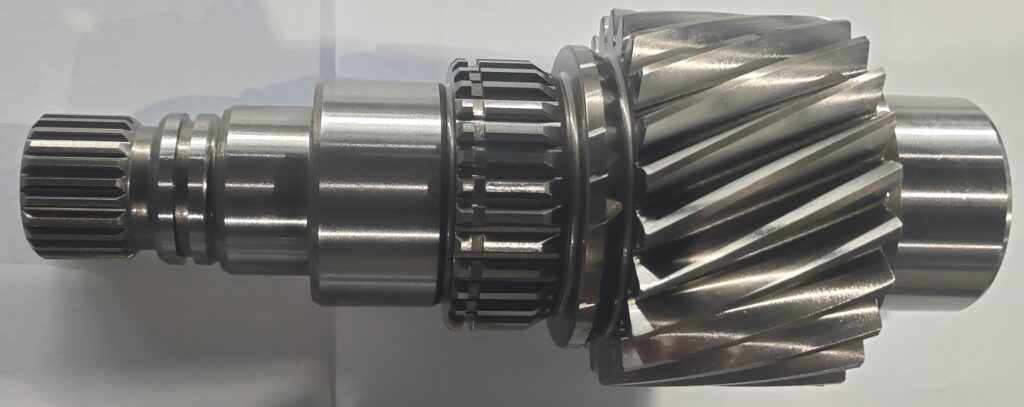Gear Parameter Design is a crucial aspect of gearbox design. The quality of the gear parameter design directly determines the performance of the gearbox. Gear parameter design typically needs to consider factors such as strength, noise, efficiency, and weight. How can the basic parameters of gears be designed reasonably?
- Module Selection (mn)
The size of the module is determined by the bending strength of the gear. Increasing the module can improve the bending strength, while decreasing the module increases the overlap ratio, which helps reduce vibration and noise. A smaller module also reduces the sliding ratio, which improves gear efficiency and reduces wear. For applications requiring high reliability but not high speed, such as in construction machinery transmission, larger modules are preferred. In high-speed, noise-sensitive applications, such as automotive transmissions and high-speed gear drives, smaller modules should be selected as long as strength requirements are met. Additionally, for mass-produced gears, a non-standard module design can be used to balance strength, noise, weight, and other factors.
- Pressure Angle Selection (αn)
For standard gear designs, a 20° pressure angle is typically used. Increasing the pressure angle can enhance the gear’s contact and bending fatigue strength, while reducing the sliding ratio. Larger pressure angles, such as 22.5°, 25°, or 27°, are commonly used in low-speed, heavy-load transmissions, like those in construction machinery. Decreasing the pressure angle improves the face overlap ratio but increases the sliding ratio. Smaller pressure angles, such as 14.5°, 15°, 16°, 17°, or 18°, are used in noise-sensitive applications like automotive transmissions and high-speed gearboxes.
- Number of Teeth (z)
The number of teeth must meet the transmission ratio requirements. Increasing the number of teeth enhances the face overlap ratio and transmission smoothness, making it ideal for high-speed gear transmissions. It is recommended that the number of teeth on the smaller gear be more than 30 for such applications. Decreasing the number of teeth allows for a larger module, which is mainly used in low-speed, heavy-load transmissions, but root undercut should be avoided. For example, in construction machinery, the minimum number of teeth can be as low as 7 to 9. In noise-sensitive applications, the number of teeth should be selected to avoid resonance with excitation sources.
- Helix Angle Selection (β)
The design of the helix angle mainly considers axial overlap and axial force. Increasing the helix angle improves axial overlap but also increases axial force. For single helical gears in low-speed, heavy-load applications, the helix angle typically ranges from 8° to 15°, ensuring an axial overlap greater than 1.1. In high-speed, noise-sensitive applications, the helix angle ranges from 15° to 30°, ensuring an axial overlap of more than 2.0. For herringbone gears, the helix angle generally ranges from 25° to 35°, with the axial overlap on each side usually exceeding 3.0.
- Gear Width (b) and Width-to-Diameter Ratio (φd)
Gear width is mainly determined by the gear’s load capacity. Increasing gear width raises load capacity but reduces the stiffness of the gear shaft, making it more sensitive to deformation and manufacturing errors, which can lead to uneven load distribution and shorter gear life. A smaller gear width ensures sufficient axial stiffness and reduces sensitivity to deformation and manufacturing errors, but it may increase the outer diameter of the gear. The width-to-diameter ratio (φd) can be designed according to the table below (φd refers to the ratio of gear width to the reference diameter of the smaller gear).
| Support Type for Small Gear | Recommended Value | Maximum Value |
|---|---|---|
| Symmetric Support | 0.4~0.9 | 1.6 |
| Asymmetric Support | 0.3~0.6 | 1.2 |
| Cantilevered Support | 0.2~0.4 | 0.55 |
- Profile Shift Coefficient (xn)
The profile shift coefficient can be designed by referencing the article “Definition and Design Considerations of Gear Profile Shift” from this platform.
- Addendum Coefficient (ha)
For standard gears, the addendum coefficient is generally ha* = 1.0. In non-standard gear designs, this coefficient can be greater or less than 1. For applications requiring smooth operation and low noise, a fine-tooth design combined with a small pressure angle can increase the face overlap ratio to more than 2.0, and the addendum coefficient can be set between 1.1 and 1.5. However, a higher addendum coefficient increases the sliding ratio and may result in sharp tooth tips. In cases where the addendum needs to be reduced, such as internal gears to prevent meshing interference, a lower addendum coefficient of 0.8 to 0.9 can be used.
- Clearance Coefficient (cn)
For standard gears, the clearance coefficient is typically cn* = 0.25. Other standard values include 0.3, 0.35, and 0.4. A larger clearance coefficient allows for a larger root fillet radius or increases the distance between the involute meshing circle and the base circle. For general designs, the clearance coefficient should not be less than 0.2.
- Root Fillet Radius Coefficient (ρf)
Increasing the root fillet radius coefficient improves the bending strength of the gear. Detailed design values for the root fillet radius coefficient can be found in the article “Root Fillet Radius Coefficient Design Considerations” on this platform.
- Top Land Thickness Coefficient (Sn)
The top land thickness coefficient is the ratio of the normal top land thickness to the normal module. To prevent full quenching of the top land, the coefficient should generally be greater than 0.4.
- Sliding Ratio (η)
To improve gear meshing efficiency and reduce wear, it is recommended to design for a low sliding ratio.
Thank you for reading. Looking forward to serving you with our exceptional gear solutions. #BeyondGears #GearManufacturing #MadeInChina
Read More:


